 Part of my day job involves building virtual and augmented reality sets for classrooms. I have built dozens of systems and have tried all sorts of different combinations of hardware, we even build software that uses this tech. I get virtual and augmented reality and I’m looking forward this fighter pilot technology finding its way into motorcycle helmets.
Part of my day job involves building virtual and augmented reality sets for classrooms. I have built dozens of systems and have tried all sorts of different combinations of hardware, we even build software that uses this tech. I get virtual and augmented reality and I’m looking forward this fighter pilot technology finding its way into motorcycle helmets.
I saw a tweet today that suggests it’s already here in the Cross Helmet. 360° peripheral awareness is a great idea that will no doubt save lives, and having hands free navigational information is another valuable safety feature, but I have a questions about this revolutionary lid.
Most of the articles I’ve read about the Cross Helmet are by tech websites that have a hard time containing their enthusiasm about disrupting existing industries. They typically suggest that motorcycle helmets haven’t changed in decades and that they are low tech, unimaginative things created by Luddites. It’ll take the blinding talents of a technology company to interrupt those conservative curmudgeons in the helmet industry (sorry, sometimes the hyperbole around high-tech companies gets a bit tiresome).
Helmets aren’t supposed to be an infotainment system, they supposed to be a light-weight, effective protective item that operates in incredibly difficult circumstances. Helmet manufacturers have thrown everything imaginable at this problem, producing carbon fibre helmets and pushing materials engineering to the limit in creating the lightest, most protective lids possible. They’ve also applied modern aerodynamic analysis to their products, producing quieter, less buffeting protection than ever before. To call them uninspired and backwards simply isn’t true.
The most concerning thing about the Cross Helmet isn’t the wiz-bang technology in the thing, it’s the thing itself. That is a massive lid. When was the last time you needed two hands to hold on to your helmet? This size is a function of all the technology crammed into it. A heads up display, rear facing camera, wireless connectivity, communications and the battery needed to power all that stuff weighs down the helmet and makes it big. The actual weight of it appears to be a mystery. Modern helmets weigh between one and two kilos, with the heaviest ones being mechanical flip top items with built in sun visors. I can’t find a weight listed for the Cross Helmet anywhere, not even on their website.
| … that’s all you get for technical details. |
I’m guessing, based on the size and tech in the thing that it’ll come in at over twice the weight of what an average helmet does, which doesn’t make it a very good helmet. On top of that, you’re looking at a slab sided thing that looks like it’ll catch cross winds like a sail. You might be able to see behind you and get navigational details, but you’ll be stopping often because your neck can’t take it any more.
I get that the first prototype of a new design is going to have problems; this is the worst smart helmet you’ll ever see because it’s the first one. As the tech gets smaller and designs improve, a smart helmet becomes a much more attractive idea, but I’m disinclined to dive into a (very) expensive helmet that is more of a concept than a usable thing.
Here is a list of some helmets currently on the market with their weights:
Arai DT-X 1619 grams (and check out the many technical details shared)
Roof Boxer Helmet 1650 grams (again with many technical details shared)
Roof Boxer Carbon 1550 grams (the lightest transformable/mechanical helmet I can find)
Nexx Carbon 1219 grams (the lightest helmet I can find)
Shark Evoline 1960 grams (the heaviest helmet I could find)
 The lightest of them use every materials engineering trick in the book to produce helmets that meet stringent modern safety standards while also being comfortable, aerodynamic and long lasting. They are anything but an old-school product, Discovery Channel.
The lightest of them use every materials engineering trick in the book to produce helmets that meet stringent modern safety standards while also being comfortable, aerodynamic and long lasting. They are anything but an old-school product, Discovery Channel.
The Roof Carbon is the lightest transformable / mechanical helmet on the market. It’s 100 grams lighter than the standard Roof Boxer helmet – that’s what you get with carbon, 100 grams. The helmet industry is playing a game of grams, aerodynamics and safety effectiveness in a state of the art way.
If you put a 2000 gram limit on your smart helmet and required it to retain the aerodynamics and size of current lids, it would be in the vicinity of current helmets in terms of usefulness. I doubt it’s possible to cram cameras, heads up displays, communications and batteries into a helmet using today’s tech, but someday soon? Perhaps.
 |
| Under those awesome graphics are state of the art materials engineering resulting in unprecedented protection. |
from Blogger https://ift.tt/2IltC9l
via IFTTT

















































